Wk 11
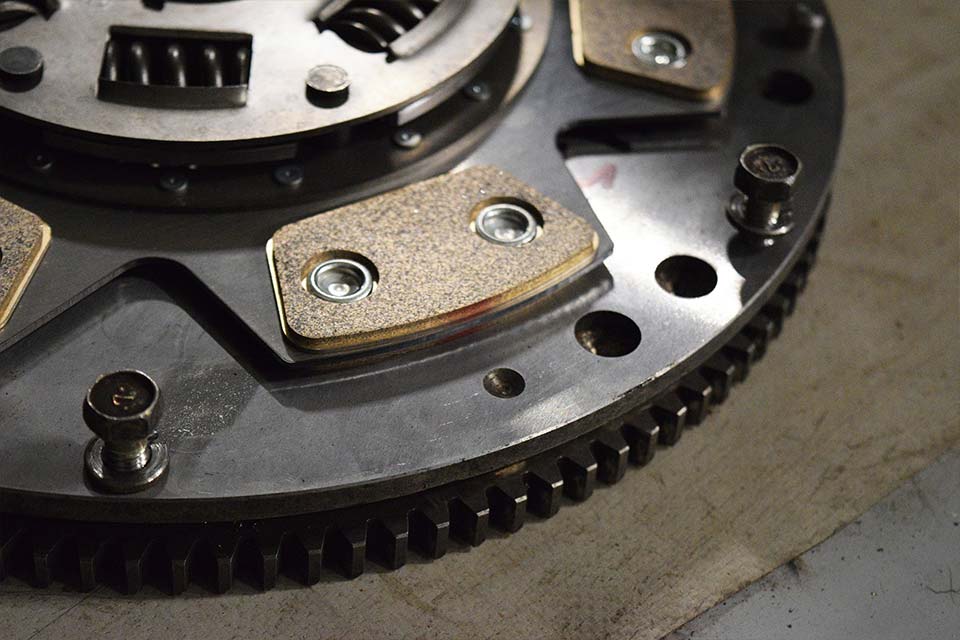

Clutch Drive System Design
- Definition
- Plate Clutches
– Constant Pressure– Constant Wear- Cone Clutches
– Constant Pressure– Constant Wear- Worked Examples
Belt Drive System Design
- Introduction
- Power Transmission
- Crossed Belt Drives
- Ratio of Belt Tensions
- Centrifugal Tension
- Belt Speed for Maximum Power Transmission
- Initial Belt Tension
- Vee-Belt Drives
- Worked Examples
- (cont.)
- Uniform Pressure:
$ W = \pi . p \bigg( r_1^2 - r_2^2 \bigg) \therefore p = \frac{W}{\large \pi ( r_1^2 - r_2^2 )} $
and:
$ T = \frac{2}{3}\pi . \mu .p ( r_1^3 - r_2^3 ) $
Finally:
$ T = \frac{2}{3} . \mu . W \frac{(\large r_1^3 - r_2^3 )}{(\large r_1^2 - r_2^2 )} $
- Uniform Wear:
$ W = 2 \pi . \int\limits_{r_2}^{r_1} p .r .dr = 2 \pi . p .r . \int\limits_{r_2}^{r_1} dr $
$ = 2 \pi . c \int\limits_{r_2}^{r_1} dr = 2 \pi . c (r_1 - r_2)$
Therefore:
$ T = 2 \pi \mu . \int\limits_{r_2}^{r_1} p .r^2 .dr \; \Rightarrow T = 2 \pi \mu . p r \int\limits_{r_2}^{r_1} r .dr $
and:
$ \Rightarrow T = 2 \pi \mu . c \int\limits_{r_2}^{r_1} r .dr = \mu W \frac{r_1 + r_2}{2}$
Finally:
$ \Rightarrow T = \mu WR \quad Eqn \; (3.2) $
- Application of Equations
– Uniform Pressure – new clutch– Uniform Wear – worn clutch

Definition
- A clutch is a friction device designed to permit the connection and disconnection of power transmission shafts.
Figure 3.1 shows a typical single plate clutch schematic arrangement where the inner plate is free to slide on axial splines cut in a hub keyed to the driving shaft. The outer plate is free to slide axially in splines cut in a housing keyed to the driven shaft. The axial force exerted on the plates by a toggle mechanism is transmitted through each plate.
Figure 3.1
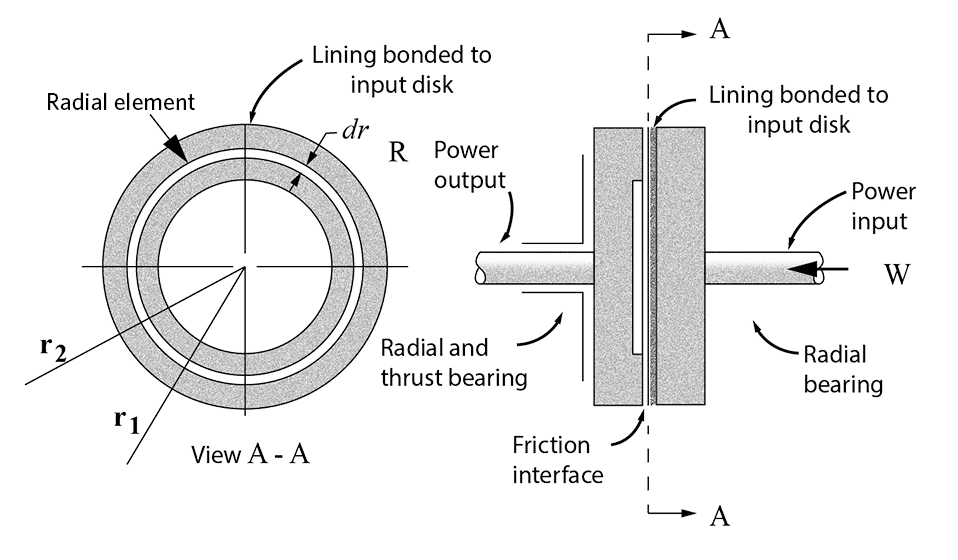
- Two plates held in contact by axial thrust force ‘W’:
$ \text{– Normal force on elementary ring} = p.2πr.dr $$ \text{– Total axial force,} W = 2 \pi. \int\limits_{\large r_2}^{\large r_1} p .r .dr $$ \text{– Friction force on elementary ring} = \mu .p.2 \pi r.dr $
- And, Moment of friction force about the axis $ = \mu .p.2 \pi r.dr $
- Torque Transmitted: $ \text{Torque transmitted,} T = 2 \pi \mu \int\limits_{r_2}^{r_1} p .r^2 .dr $
Multiple Plate Clutch
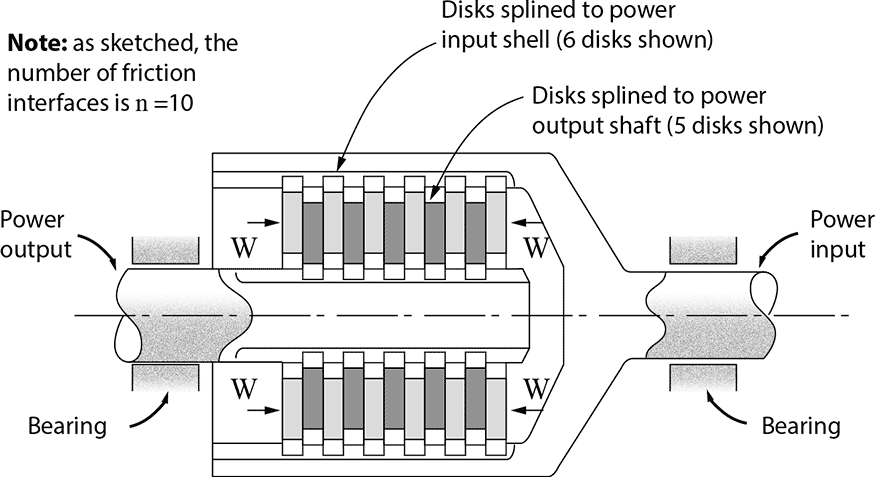 • Figure 3.2: A typical multi-plate clutch arrangement.
• Figure 3.2: A typical multi-plate clutch arrangement.
- Uniform Pressure:
- (Cont.)
- Total friction drag on ring $ \normalsize = \mu . p . 2 \pi . r . \large \frac{dr}{sin \; \beta} \small \; (= \mu \; x \; \text{normal force)} $
∴ Moment of force about axis $ \normalsize = \mu . p . 2 \pi . r^2 . \large \frac{dr}{sin \; \beta} $
∴ Torque transmitted, $ T \normalsize = \large \frac{2 \pi \mu}{sin \; \beta} \normalsize . \int\limits_{r_2}^{r_1} p . r^2 . dr $
- Uniform Pressure
$ \normalsize T = \large \frac{2}{3} . \frac{\mu . W}{sin \; \beta} \frac{(r_1^3 - r_2^3 )}{((r_1^2 - r_2^2 ))} \normalsize $
- Uniform Wear
$ T = \large \frac{\mu.W}{2 sin \; \beta} \normalsize (r_1 + r_2)$
- Or
$ T = \large \frac{\mu.W R}{sin \; \beta} \normalsize \; $
- ⬇ Clutches Worked Example

Cone Clutches
- 📷 A cone clutch diagram - seen here larger

- Normal force on elementary ring
$ \normalsize = p.2 \pi .r . \large \frac{dr}{sin \; \beta} $
- Axial component of normal force
$ \normalsize = p.2 \pi .r . \large \frac{dr}{sin \; \beta} \normalsize . sin \; \beta = 2 \pi . p . r .dr $
∴ Total axial force,
$ W = 2 \pi . \int\limits_{r_2}^{r_1} p .r .dr $
 Figure 3.3: A typical cone clutch.
Figure 3.3: A typical cone clutch.
- Total friction drag on ring $ \normalsize = \mu . p . 2 \pi . r . \large \frac{dr}{sin \; \beta} \small \; (= \mu \; x \; \text{normal force)} $
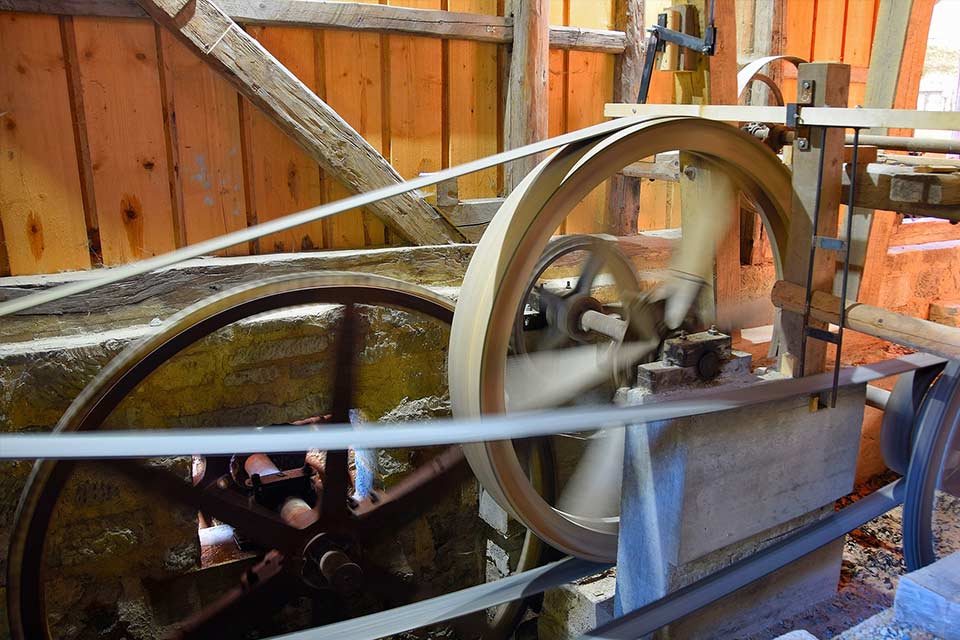
Power Transmission
- F1 = the ‘tight side’ tension
- F2 = the ‘slack side’ tension
- Pulley drives the belt in a clockwise direction, and assuming no slip linear speed of belt is equal to peripheral speed of pulley
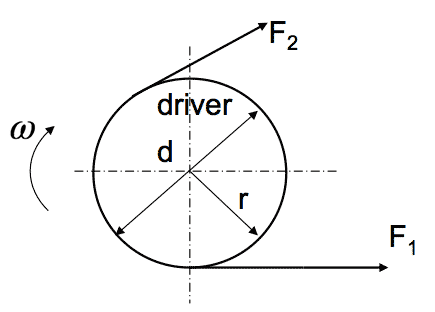

Belt Drive System Design
Introduction
- 📷 Types of Belt
– Flat belt– Vee-type belt- Advantages
– Quiet running– Clean and easy to maintain– Relatively economical- Features
– Continuous belt– Pulleys keyed to shaft– Frictional contact between belt and pulley- Belt Drives - Introduction
Power may be transmitted by means of a belt drive (either flat or vee-type) with the main advantages gained in using them including quiet running, clean and easy to maintain, and relatively economical. The belt is continuous and passes over pulleys which are keyed to shafts. The effectiveness of a belt drive depends upon friction between the belt and the pulley, and on the angle of contact between the belt and the pulley surface. Before belt drives now are considered in detail, consider Figure 4.1:
Figure 4.1: A typical multi-plate clutch arrangement.
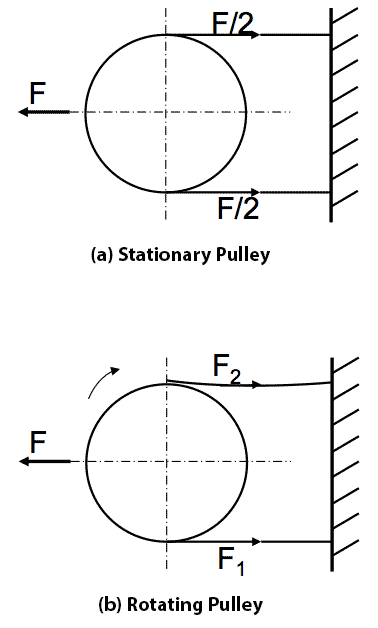

- F1 = the ‘tight side’ tension
- Crossed Belt Drive
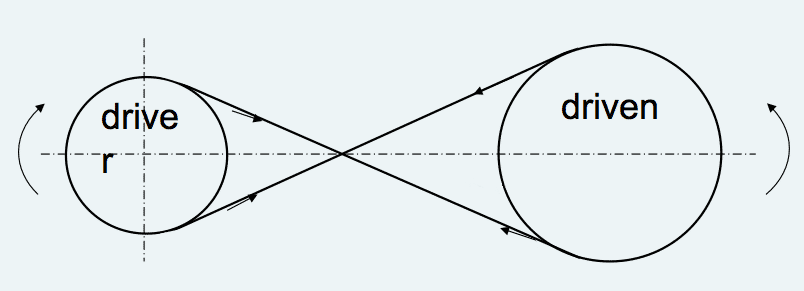
Ratio of Belt Tensions
- Power transmitted depends on F1 – F2
- For a higher ratio of F1 / F2 more power will be transmitted
– However there is a limiting ratio at which the belt will slip on the pulley:– Ratio of F1 / F2 depends on:the coefficient of friction (μ) between the belt and the pulley;the angle of lap (θ) of the belt round the pulley, and that an increase in either μ and θ will lead to an increase in the ratio (F1/F2)- It can be shown that the limiting ratio of tensions (F1/F2) is given by: $ \large \frac{F_1}{F_2} \normalsize = e ^{\mu \theta} $
- Angle of Lap
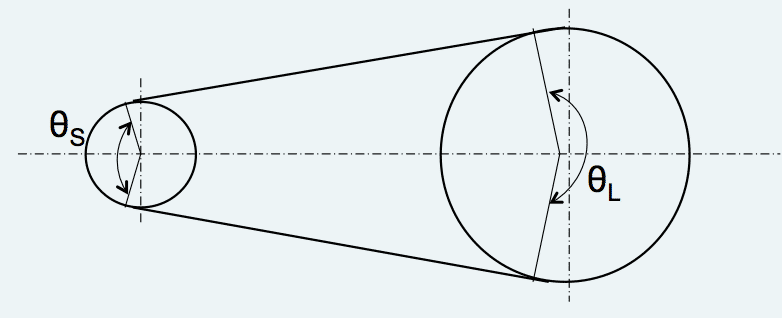

Power Transmission (Cont.)
- Net clockwise torque on the pulley
T = F1.r – F2.r = (F1 – F2)r
- Now, Power
P = Tω ∴ P = (F1 – F2)rω
- The difference in tensions (F1 – F2) is referred to as the effective tangential force.
- Also, note that since v = ωr, then:
P = (F1 – F2)v (W)
- Angle of Lap
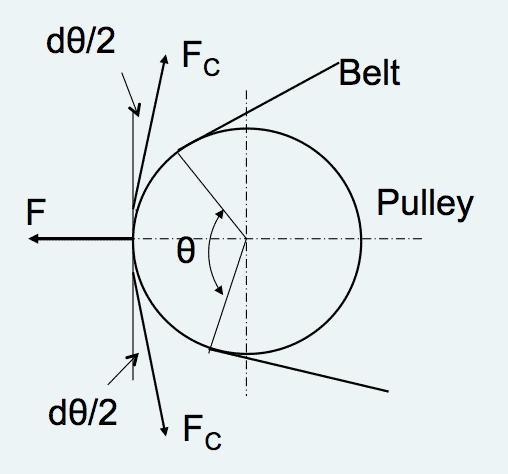 θ represents the angle of lap, i.e. angle of contact between belt and pulley.
θ represents the angle of lap, i.e. angle of contact between belt and pulley.
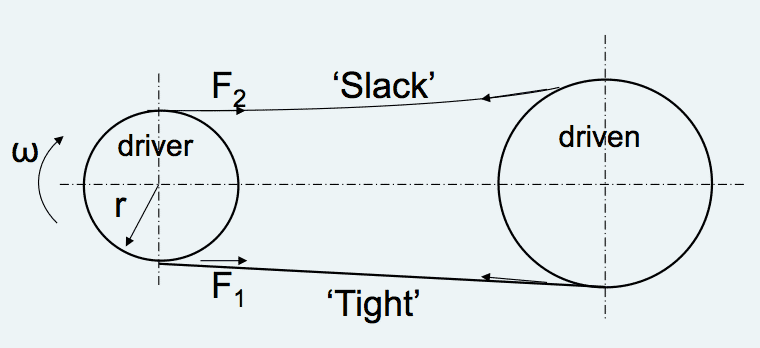
Belt Speed for Maximum Power Transmission
- Power transmitted:
(F1 – F2)v = [(F1 – FC) - (F2 – FC)]v
- From previous:
$ F_2 - F_c = \large \frac{F_1 - F_c}{e ^{\mu \theta}} $
- Therefore, power transmitted:
$ (F_1 - F_c) (1 - \frac{\large 1}{e ^{\large \mu \theta}} ) v = k (F_1 - mv^2) v \; \; Eqn \; (4.5) $
- Where:
$ k = constant = 1 - \frac{\large 1}{e ^{\large \mu \theta}} $
- For maximum power, differentiate with respect to velocity and equate to 0:
$ \frac{\large d [( F_1 - mv ^2)v]}{\large dv} = 0 $
- Hence, F1 – 3mv2 = 0
- Therefore, FC = F1/3 (N)
- The maximum power is then obtained by substituting this value of FC and the corresponding value of $ v $ in Eqn 4.5 above.
- During start-up, no centrifugal effects are present and therefore power transmitted will be different from that under normal conditions
Initial Belt Tension
- Initial tension in belt is F0
- Once running:
– The tension in the tight side increases from F0 to F1 and– On the slack side decreases from F0 to F2- Assuming Hooke’s law is obeyed and the length remains constant:
F1 – F0 = F0 – F2 and
F1 + F2 = 2F0
Centrifugal Tension
- Belt has mass per unit length (m)
- Fc is the centrifugal tension
- Centrifugal force acting on an element of belt:
$ F = 2.F_c.sin \frac{\large d \theta}{\large 2} =2 . F _c. \frac{\large d \theta}{\large 2} $
- Mass of belt section $ = m.r.d \theta $
- Centrifugal force = mv2/r
- Therefore:
$ (m.r.d \theta) \frac{\large v^2}{\large r} = F_c. d \theta $
$ \Rightarrow F_c = mv^2 $
 θ represents the angle of lap, i.e. angle of contact between belt and pulley.
θ represents the angle of lap, i.e. angle of contact between belt and pulley.
- Allowance for Centrifugal Tension
$ \large \frac{F_1 - F_c}{F_2 - F_c} = e ^{\mu \theta} $
- F1 – FC and F2 – FC are the effective driving tensions
- Power transmitted:

Vee Belts
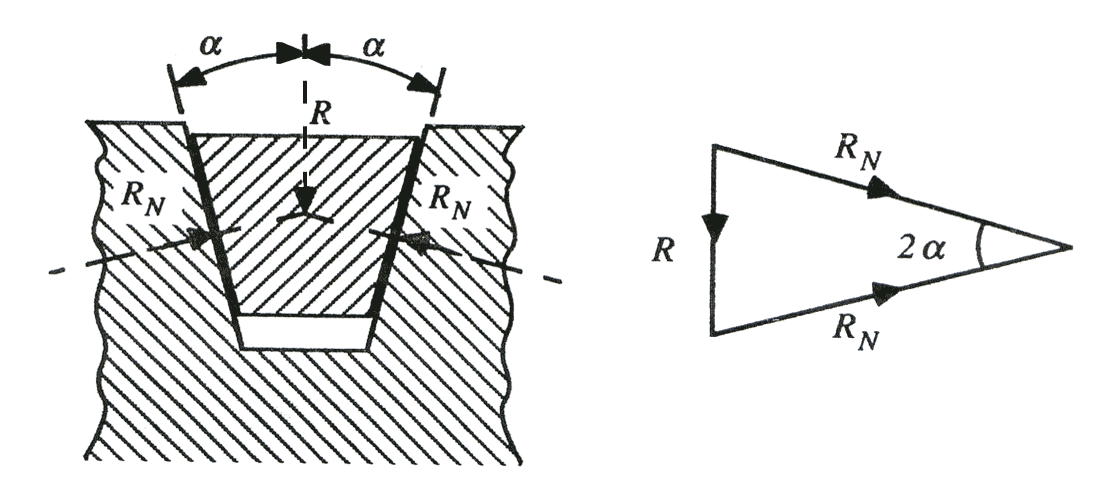
- The belt tension sets up a radial force R acting towards the centre of the pulley
$$ sin \; \alpha = \frac{R/2}{R_N} \quad \quad \frac{R}{2} = R_N \; sin \; \alpha $$ therefore:
$$ R = 2R_N \; sin \; \alpha \quad \quad 2R_N = \frac{R}{sin \; \alpha} $$
- Now, for flat belts, the friction force = μR (see above)
- And for vee-belts, the friction force = 2μRN (two friction surfaces) =
$$ \frac{\mu R}{sin \; \alpha} $$
- Hence, the belt tension formula for flat belts is modified for vee-belts and becomes:
$$ \frac{F_1}{F_2} = e ^{\frac{\Large \mu \theta}{\Large sin \; \alpha}} $$- ⬇ Belt Drive Worked Example
Note: A further measure that can be taken to avoid buckling, is to ensure that the spring index C is as large as possible.Hinged Ends - Lf /D Hinged Ends - KL Built-in-Ends - Lf /D Built-in-Ends - KL 1 0.72 1 0.72 2 0.63 2 0.71 3 0.38 3 0.68 4 0.20 4 0.63 5 0.11 5 0.53 6 0.07 6 0.38 7 0.05 7 0.26 8 0.04 8 0.19
-

Summaries
- ⬇ Clutches and Belt Drives Summary
Clutches
- 📷 Nomenclature for Clutches
Flat Belt Summary
- Main factors governing difference in tensions
– Angle of LapPulley DiametersPulley Centre Distance– Coefficient of FrictionLimited by requirement for smooth pulley surfaceCan use a semi-liquid preservative compound to increase friction
Vee Belt Summary
- Typical groove angle around 400
- Belt should not contact the bottom of the groove
- Same design procedure as flat belts
– Pulley centre distance– Belt tensions– Power transmittedBelt cross-sectional areaNumber of belts requiredSymbol Description Unit A Contact area m2 dr Small portion of contact disc m n Number of contact pairs (plate clutch) - p Intensity of pressure between contact surfaces Nm-2 R Mean radius m r1 Outer radius m r2 Inner radius m T Transmitted torque Nm W Axial thrust force N β Cone angle degrees μ Coefficient of friction - -
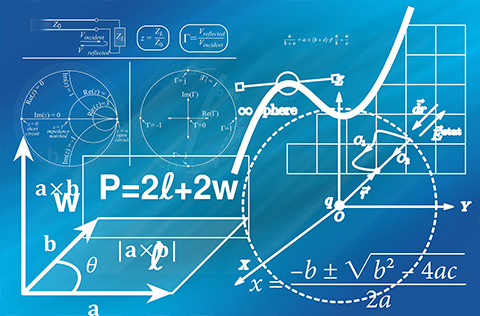

Tutorials
- ⬇ Clutches Tutorial
- ⬇ Belt Drives Tutorial